Last Saturday, Irish born Maureen O’Hara, one of the icons of Hollywood’s Golden Age, has died. The feisty and fearless actress starred in John Ford’s Oscar-winning drama How Green Was My Valley (1941), set in Wales, and Ford’s Irish-set The Quiet Man (1952) opposite John Wayne. The famously red-headed actress also worked successfully with Charles Laughton at Jamaica Inn (1939) and The Hunchback of Notre Dame (1939), starred in the perennial Christmas hit Miracle on 34th Street (1947), and appeared in the Disney children’s hit The Parent Trap (1961). O'Hara was 95.
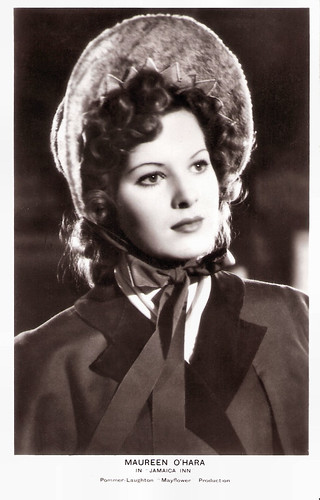
British postcard, London, no. FS 200. Photo: Pommer-Laughton 'Mayflower' production. Publicity still for Jamaica Inn (Alfred Hitchcock, 1939).
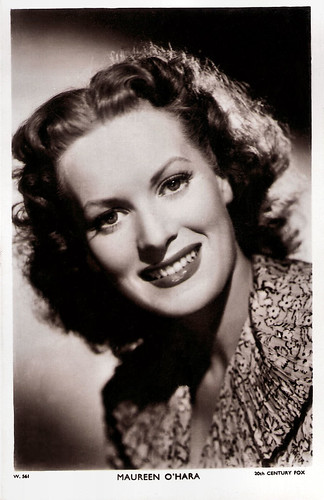
British postcard in the Picturegoer Series, London, no. W 561. Photo: 20th Century Fox.
Maureen O’Hara was born Maureen FitzSimons in the Dublin suburb of Ranelagh, Ireland, in 1920. Her mother, Marguerita Lilburn FitzSimons, was an accomplished contralto. Her father, Charles FitzSimons, managed a business in Dublin and also owned part of the renowned Irish soccer team The Shamrock Rovers.
From the age of 6 to 17, Maureen trained in drama, music and dance, and at the age of 10 she joined the Rathmines Theatre Company and worked in amateur theatre in the evenings after her lessons. O'Hara's dream at this time was to be a stage actress. By age 14 she was accepted to the prestigious Abbey Theatre and pursued her dream of classical theatre and operatic singing.
Her first screen test was for a British film called Kicking the Moon Around (Walter Forde, 1938) at Elstree Studios, It was arranged by American bandleader Harry Richman, who was then appearing in Dublin. The result was deemed unsatisfactory, but when Charles Laughton later saw it he was intrigued by her large and expressive eyes.
Laughton arranged for her to co-star with him in the British film Jamaica Inn (Alfred Hitchcock, 1939). Laughton was so pleased with O'Hara's performance that she was cast in the role of Esmeralda opposite him in the Hollywood production of The Hunchback of Notre Dame (William Dieterle, 1939). The epic film was an extraordinary success and international audiences were now alerted to her natural beauty and talent.
From there, she went on to enjoy a long and highly successful career in Hollywood. Director John Ford cast her as Angharad in How Green Was My Valley (1941), which won the Academy Award for Best Picture.
O’Hara was often an example of noble and defiant womanhood, like in This Land Is Mine (Jean Renoir, 1943). In this film, she was reunited with Laughton, who plays a mother-dominated schoolteacher secretly in love with O’Hara, a colleague who is working for the wartime resistance.
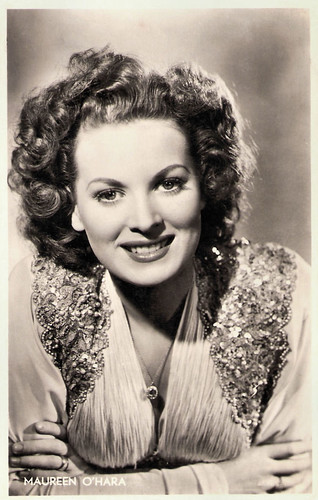
Dutch postcard by J.S.A. Photo: M.P.E.
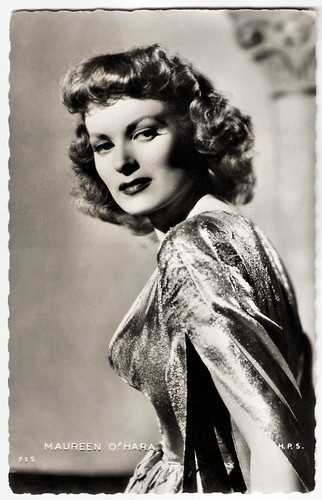
French postcard by Editions P.I., Paris, no. 715. Photo: H.P.S.
Maureen O'Hara starred in Swashbucklers such as The Black Swan (Henry King, 1942), opposite Tyrone Power, and Sinbad the Sailor (Richard Wallace, 1947), with Douglas Fairbanks, Jr. She also starred as Doris Walker and the mother of a young Natalie Wood in Miracle on 34th Street (George Seaton, 1947), which became a perennial Christmas classic.
O'Hara made a number of films with John Wayne. She met Wayne through director John Ford, and the two hit it right off. O'Hara: "I adored him, and he loved me. But we were never sweethearts. Never, ever.”
Opposite Wayne, she played Mary Kate Danaher in The Quiet Man (John Ford, 1952), an iconic film that is still very much celebrated in Ireland and abroad.
In total, they made five films together between 1948 and 1972, also including Rio Grande (John Ford, 1950), The Wings of Eagles (John Ford, 1957), McLintock! (Andrew V. McLaglen, 1963) and Big Jake (George Sherman, 1971).
O’Hara most often played strong and wilful women, but offscreen she was the same. In 1957 her career was threatened by scandal, when the tabloid Confidential magazine claimed she and a man had engaged in 'the hottest show in town' in the back row of Hollywood’s Grauman’s Chinese Theatre. However, as she later told the Associated Press, at the time she “was making a movie in Spain, and I had the passport to prove it”.
She testified against the magazine in a criminal libel trial and brought a lawsuit that was settled out of court. The magazine eventually went out of business.
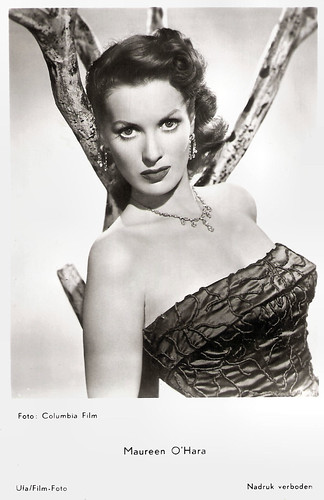
Dutch postcard by Gebr. Spanjersberg N.V., Rotterdam, no. 2028. Photo: Columbia Film / Ufa.
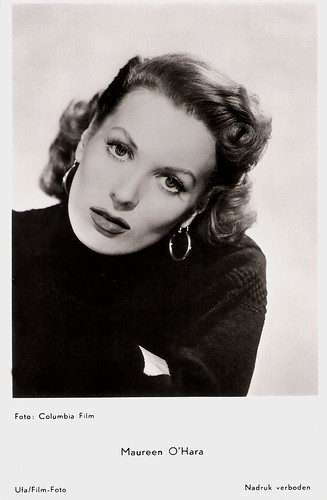
Dutch postcard by Gebr. Spanjersberg N.V., Rotterdam, no. 2029. Photo: Columbia Film / Ufa.
Maureen O'Hara was married three times. In 1939, at the age of 19, O'Hara secretly married Englishman George H. Brown, a film producer, production assistant and occasional scriptwriter, who she had met on the set of Jamaica Inn. The marriage was annulled in 1941.
Later that year, O'Hara married American film director William Houston Price (dialogue director in The Hunchback of Notre Dame), but the union ended in 1953, reportedly as a result of his alcohol abuse. They had one child, a daughter named Bronwyn FitzSimons Price (1944).
In later life, Maureen O’Hara married her third husband, Brigadier General Charles Blair. The couple lived in the US Virgin Islands, where he operated an airline. He died in a plane crash in 1978 and O’Hara took over management of the airline, which she eventually sold. “Being married to Charlie Blair and travelling all over the world with him, believe me, was enough for any woman,” she said in 1995. “It was the best time of my life.”
O'Hara remained retired from acting until 1991, when she starred in the film Only the Lonely (Chris Columbus, 1991), playing Rose Muldoon, the domineering mother of a Chicago cop played by John Candy. Ronald Bergan in his obituary in The Guardian: "she acted everyone else off the screen, a reminder of just how much the cinema had missed her."
In the following years, she continued to work, starring in several made-for-TV films. Her autobiography, 'Tis Herself, was published in 2004 and was a New York Times Bestseller. In 2005 she moved back to Ireland, settling in her house on a 35-acre estate, Lugdine Park, in west Cork, which she had bought with Blair in 1970. In 2012 she returned to the US to be closer to her family as her health declined.
She was never nominated for an Oscar, instead being given an honorary award in 2014. After accepting her statuette from a wheelchair, the then 94-year-old star protested when her speech of thanks was cut short.
Maureen O'Hara died in her sleep at home in Boise, Idaho. She is survived by her daughter, Bronwyn, and by a grandson and two great-grandchildren.
Trailer for Jamaica Inn (Alfred Hitchcock, 1939). Source: Cohen Film Collection (YouTube).
Trailer for The Quiet Man (John Ford, 1952). Source: Eurekaentertainment (YouTube).
Sources: Ronald Bergan (The Guardian), Wikipedia and IMDb.

British postcard, London, no. FS 200. Photo: Pommer-Laughton 'Mayflower' production. Publicity still for Jamaica Inn (Alfred Hitchcock, 1939).

British postcard in the Picturegoer Series, London, no. W 561. Photo: 20th Century Fox.
Alfred Hitchcock
Maureen O’Hara was born Maureen FitzSimons in the Dublin suburb of Ranelagh, Ireland, in 1920. Her mother, Marguerita Lilburn FitzSimons, was an accomplished contralto. Her father, Charles FitzSimons, managed a business in Dublin and also owned part of the renowned Irish soccer team The Shamrock Rovers.
From the age of 6 to 17, Maureen trained in drama, music and dance, and at the age of 10 she joined the Rathmines Theatre Company and worked in amateur theatre in the evenings after her lessons. O'Hara's dream at this time was to be a stage actress. By age 14 she was accepted to the prestigious Abbey Theatre and pursued her dream of classical theatre and operatic singing.
Her first screen test was for a British film called Kicking the Moon Around (Walter Forde, 1938) at Elstree Studios, It was arranged by American bandleader Harry Richman, who was then appearing in Dublin. The result was deemed unsatisfactory, but when Charles Laughton later saw it he was intrigued by her large and expressive eyes.
Laughton arranged for her to co-star with him in the British film Jamaica Inn (Alfred Hitchcock, 1939). Laughton was so pleased with O'Hara's performance that she was cast in the role of Esmeralda opposite him in the Hollywood production of The Hunchback of Notre Dame (William Dieterle, 1939). The epic film was an extraordinary success and international audiences were now alerted to her natural beauty and talent.
From there, she went on to enjoy a long and highly successful career in Hollywood. Director John Ford cast her as Angharad in How Green Was My Valley (1941), which won the Academy Award for Best Picture.
O’Hara was often an example of noble and defiant womanhood, like in This Land Is Mine (Jean Renoir, 1943). In this film, she was reunited with Laughton, who plays a mother-dominated schoolteacher secretly in love with O’Hara, a colleague who is working for the wartime resistance.

Dutch postcard by J.S.A. Photo: M.P.E.

French postcard by Editions P.I., Paris, no. 715. Photo: H.P.S.
John Wayne
Maureen O'Hara starred in Swashbucklers such as The Black Swan (Henry King, 1942), opposite Tyrone Power, and Sinbad the Sailor (Richard Wallace, 1947), with Douglas Fairbanks, Jr. She also starred as Doris Walker and the mother of a young Natalie Wood in Miracle on 34th Street (George Seaton, 1947), which became a perennial Christmas classic.
O'Hara made a number of films with John Wayne. She met Wayne through director John Ford, and the two hit it right off. O'Hara: "I adored him, and he loved me. But we were never sweethearts. Never, ever.”
Opposite Wayne, she played Mary Kate Danaher in The Quiet Man (John Ford, 1952), an iconic film that is still very much celebrated in Ireland and abroad.
In total, they made five films together between 1948 and 1972, also including Rio Grande (John Ford, 1950), The Wings of Eagles (John Ford, 1957), McLintock! (Andrew V. McLaglen, 1963) and Big Jake (George Sherman, 1971).
O’Hara most often played strong and wilful women, but offscreen she was the same. In 1957 her career was threatened by scandal, when the tabloid Confidential magazine claimed she and a man had engaged in 'the hottest show in town' in the back row of Hollywood’s Grauman’s Chinese Theatre. However, as she later told the Associated Press, at the time she “was making a movie in Spain, and I had the passport to prove it”.
She testified against the magazine in a criminal libel trial and brought a lawsuit that was settled out of court. The magazine eventually went out of business.

Dutch postcard by Gebr. Spanjersberg N.V., Rotterdam, no. 2028. Photo: Columbia Film / Ufa.

Dutch postcard by Gebr. Spanjersberg N.V., Rotterdam, no. 2029. Photo: Columbia Film / Ufa.
John Candy's domineering mother
Maureen O'Hara was married three times. In 1939, at the age of 19, O'Hara secretly married Englishman George H. Brown, a film producer, production assistant and occasional scriptwriter, who she had met on the set of Jamaica Inn. The marriage was annulled in 1941.
Later that year, O'Hara married American film director William Houston Price (dialogue director in The Hunchback of Notre Dame), but the union ended in 1953, reportedly as a result of his alcohol abuse. They had one child, a daughter named Bronwyn FitzSimons Price (1944).
In later life, Maureen O’Hara married her third husband, Brigadier General Charles Blair. The couple lived in the US Virgin Islands, where he operated an airline. He died in a plane crash in 1978 and O’Hara took over management of the airline, which she eventually sold. “Being married to Charlie Blair and travelling all over the world with him, believe me, was enough for any woman,” she said in 1995. “It was the best time of my life.”
O'Hara remained retired from acting until 1991, when she starred in the film Only the Lonely (Chris Columbus, 1991), playing Rose Muldoon, the domineering mother of a Chicago cop played by John Candy. Ronald Bergan in his obituary in The Guardian: "she acted everyone else off the screen, a reminder of just how much the cinema had missed her."
In the following years, she continued to work, starring in several made-for-TV films. Her autobiography, 'Tis Herself, was published in 2004 and was a New York Times Bestseller. In 2005 she moved back to Ireland, settling in her house on a 35-acre estate, Lugdine Park, in west Cork, which she had bought with Blair in 1970. In 2012 she returned to the US to be closer to her family as her health declined.
She was never nominated for an Oscar, instead being given an honorary award in 2014. After accepting her statuette from a wheelchair, the then 94-year-old star protested when her speech of thanks was cut short.
Maureen O'Hara died in her sleep at home in Boise, Idaho. She is survived by her daughter, Bronwyn, and by a grandson and two great-grandchildren.
Trailer for Jamaica Inn (Alfred Hitchcock, 1939). Source: Cohen Film Collection (YouTube).
Trailer for The Quiet Man (John Ford, 1952). Source: Eurekaentertainment (YouTube).
Sources: Ronald Bergan (The Guardian), Wikipedia and IMDb.
No comments:
Post a Comment